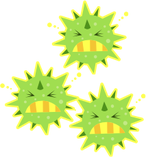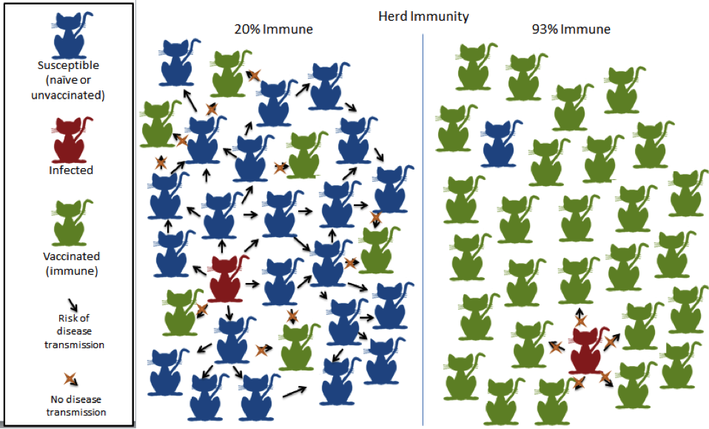Minutes to Prevention and Population Protection: The Importance of Vaccination at Intake

By Becky Stuntebeck, DVM, DCHS-UC Davis KSMP Intern
What does it mean to vaccinate at intake?
Research studies show that dogs and cats can develop protective immune responses to vaccination within hours to days. What does this mean to your shelter? It means that delaying vaccination of incoming animals by even a few hours may increase the risk of serious disease outbreaks occurring in your shelter population. Shelter experts are even recommending that animals be vaccinated BEFORE arriving in the shelter whenever possible; in some communities animal control officers vaccinate before bringing a stray in, and in other areas shelters choose to schedule vaccination appointments a week or two before allowing animals to be surrendered to the shelter.
What does it mean to vaccinate at intake?
Research studies show that dogs and cats can develop protective immune responses to vaccination within hours to days. What does this mean to your shelter? It means that delaying vaccination of incoming animals by even a few hours may increase the risk of serious disease outbreaks occurring in your shelter population. Shelter experts are even recommending that animals be vaccinated BEFORE arriving in the shelter whenever possible; in some communities animal control officers vaccinate before bringing a stray in, and in other areas shelters choose to schedule vaccination appointments a week or two before allowing animals to be surrendered to the shelter.
|
Animal shelters are full of germs! By bringing animals of different age groups and backgrounds together, shelters create the perfect opportunity for infectious agents like viruses, bacteria, and even fungi (think ringworm!) to accumulate in the environment and spread rapidly through populations of stressed animals a shelter. Some of these germs, like parvovirus, can remain infectious for over a year in the environment. Good sanitation practices and appropriate husbandry are very important components of disease control in the shelter; however, outbreaks cannot be completely prevented without timely vaccination of all incoming cats and dogs.
|
Vaccine variability
Each type of vaccination varies in the time it takes to produce a protective immune response in the vaccinated animal as well as the type of protection provided by the vaccine.
Each type of vaccination varies in the time it takes to produce a protective immune response in the vaccinated animal as well as the type of protection provided by the vaccine.
|
Distemper, parvo, and panleukopenia are all severe, often fatal, viral diseases that can spread rapidly in shelter populations. However, the vaccinations for these diseases are also some of the most effective and rapidly protective vaccinations available! Distemper has been shown to provide some protection within 4 hours of being given; parvovirus vaccination is effective within 3 days. Immunity is complete and highly effective after one week; with rare exception, cats and dogs older than 20 weeks of age are completely protected for more than a year from just one vaccination.
Vaccination for herpesvirus (cause of upper respiratory infections in cats) or Bordetella (cause of kennel cough in dogs) does not prevent animals from becoming sick; however, these vaccines DO tend to lessen the severity of disease when it occurs. By vaccinating you reduce the amount of resources (staff time, medications) that need to be dedicated to managing cats and dogs with upper respiratory infections. |
In puppies and kittens less than 20 weeks old, maternal antibodies complicate the immune response to vaccines (see last month’s article here), and these animals need to be re-vaccinated every 2 weeks in the shelter environment to optimize the time to develop a protective immune response via vaccination.
Protect your herd
Vaccinating every dog and cat as soon as possible can drastically reduce both the number of animals who develop disease in an outbreak as well as the likelihood of an outbreak occurring at all. This relates to a concept called “herd immunity.” In a vaccinated population, even though individual animals may arrive sick or become ill while in the shelter, the likelihood of disease being transmitted to animals who are susceptible (such as puppies and kittens) is greatly reduced by having more immune animals in your population as illustrated below.
Protect your herd
Vaccinating every dog and cat as soon as possible can drastically reduce both the number of animals who develop disease in an outbreak as well as the likelihood of an outbreak occurring at all. This relates to a concept called “herd immunity.” In a vaccinated population, even though individual animals may arrive sick or become ill while in the shelter, the likelihood of disease being transmitted to animals who are susceptible (such as puppies and kittens) is greatly reduced by having more immune animals in your population as illustrated below.
Who shouldn’t be vaccinated at intake?
In a nutshell, almost every cat and dog entering your shelter should be vaccinated as soon as (or even before!) they enter your shelter. You may be concerned about the risk of over-vaccinating animals, but in the shelter the risks and costs of infectious disease to shelter animals are far greater than the relatively uncommon occurrences of vaccine reactions or other vaccination complications.
There are certain intake situations which may cause you to wonder whether or not to vaccinate immediately. Some of the most common are listed in the table below.
In a nutshell, almost every cat and dog entering your shelter should be vaccinated as soon as (or even before!) they enter your shelter. You may be concerned about the risk of over-vaccinating animals, but in the shelter the risks and costs of infectious disease to shelter animals are far greater than the relatively uncommon occurrences of vaccine reactions or other vaccination complications.
There are certain intake situations which may cause you to wonder whether or not to vaccinate immediately. Some of the most common are listed in the table below.
|
Animal Category: Vaccinate at Intake?
|
The cost of not vaccinating at intake will inevitably cost your shelter more money than vaccinating every incoming dog and cat as soon as possible. Staff time and cost of supplies needed to manage and mitigate disease outbreaks or treat individual sick animals accumulate rapidly. Increases in length of stay due to having more sick animals in your population also contribute to greater expenses. Finally, the opportunity cost of euthanizing previously healthy animals due to infectious disease should not be ignored. It should be a red flag to you if healthy animals coming into your shelter are leaving sick (whether by euthanasia or live release outcomes). Ultimately it just doesn’t pay to delay vaccination for any dog or cat entering your shelter!
Resources
Resources
- "Canine and Feline Vaccines and Immunology." Infectious Disease Management in Animal Shelters; Lila Miller, Kate Hurley (Editors); Paperback; 400 pages. July 2009, Wiley-Blackwell; Chapter 5, pp 61-82.
- “Guidelines for Standards of Care in Animal Shelters.” Newbury, S., Blinn, M.K., Bushby, P.A., Cox, C.B., Dinnage, J.D., Griffin, B., Hurley, K.F., Isaza, N., Jones, W., Miller, L., O'Quin, J., Patronek, G.J., Smith-Blackmore, M., Spindel, M., 2010. Available here.
- “Saving Lives with Antibody Titer Tests.” Schultz, RD, MS, PhD, ACVM; Maddie’s Institute Webcast, September 2011, available for viewing here.
- “Redefining Vaccination on Intake,” Maddie’s Institute article, April 2012, accessed August 2013. Available here.
- “Infection Control: Valuable Vaccines.” ASPCAPro Webinar, November 9, 2009. Available here



